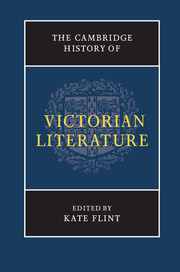Book contents
- Frontmatter
- Introduction
- PART I AUTHORS, READERS, AND PUBLISHERS
- PART II WRITING VICTORIA’s ENGLAND
- PART III MODES OF WRITING
- PART IV MATTERS OF DEBATE
- PART V SPACES OF WRITING
- 27 Spaces of the nineteenth-century novel
- 28 National and regional literatures
- 29 Britain and Europe
- 30 Victorian empire
- 31 Writing about America
- PART VI VICTORIAN AFTERLIVES
- Select bibliography
- Index
28 - National and regional literatures
from PART V - SPACES OF WRITING
Published online by Cambridge University Press: 28 March 2012
- Frontmatter
- Introduction
- PART I AUTHORS, READERS, AND PUBLISHERS
- PART II WRITING VICTORIA’s ENGLAND
- PART III MODES OF WRITING
- PART IV MATTERS OF DEBATE
- PART V SPACES OF WRITING
- 27 Spaces of the nineteenth-century novel
- 28 National and regional literatures
- 29 Britain and Europe
- 30 Victorian empire
- 31 Writing about America
- PART VI VICTORIAN AFTERLIVES
- Select bibliography
- Index
Summary
While national and regional literatures are hardly the same thing, no distinct line separates them in the nineteenth-century British Isles. Regional literature documented small pockets of culture it treated as truly national in its characteristics. Thus Wordsworth’s vision of the natural beauty of the Lake District promises readers a locality from which their English love of liberty might be revived, free of corrupting urban (or French) influences. Almost a century later, J. M. Synge’s documentation of the life of Aran Islanders on the westernmost reaches of Ireland holds out a similar promise for Ireland, detailing the cultural peculiarities of the islands where he imagined that an essential Irishness remained intact. But these examples also expose the contradiction inherent in a literature that treats a specific region as authentically national: what makes a region recognizable as national is the alien element it contains, be it the sublimity of Wordsworth’s wild landscapes or the musical inflections through which Synge apprehends a Gaelic he neither understood nor spoke.
The dynamic between region and nation in the British Isles was further vexed by the multi-national state that was the nineteenth-century United Kingdom. In this configuration, England, Wales, and Scotland, in their corporate identity as Great Britain, were united with Ireland under one Crown and one Parliament although each were to retain the distinct cultures that made them – nominally at least – separate nations. The multi-national composition of the British state complicates almost everything we might otherwise assume about the relationship between literature and national identity.
- Type
- Chapter
- Information
- The Cambridge History of Victorian Literature , pp. 598 - 621Publisher: Cambridge University PressPrint publication year: 2012
- 4
- Cited by



